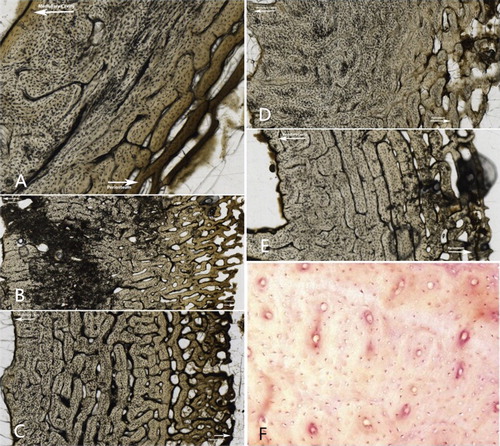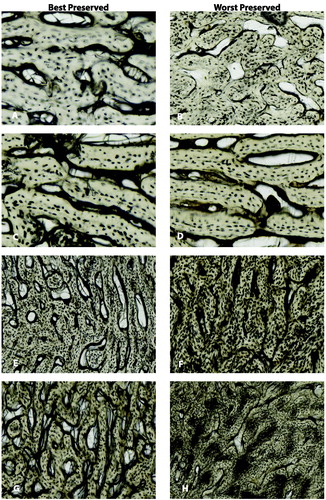Figures & data
Figure 1. Descriptions of the Oxford Histological Index (OHI) and examples from the sectioned specimens in this study. (A) No original features identifiable, other than Haversian canals (Index 0); (B) small areas of well-preserved bone present, or some lamellar structure preserved by pattern of destructive foci (Index 1); (C) clear lamellate structure preserved between destructive foci (Index 2); (D) clear preservation of some osteocyte lacunae (Index 3); (E) only minor amounts of destructive foci, otherwise generally well preserved (Index 4); (F) Very well-preserved, virtually indistinguishable from fresh bone (Index 5) (Source: Mescher AL: Junqueira’s Basic Histology: Text and Atlas 12th Edition: http://www.accessmedicine.com Copyright© The McGraw-Hill Companies, Inc. All rights reserved).

Table 1. Mean values for accumulated degree days (ADD) at skeletonization [excluding one winter juvenile that remained mummified] of the blanket foetal, bag foetal, control foetal, and surface juvenile depositions as well as mean temperature, relative humidity, daily precipitation, and soil moisture by season averaged over the 2-year study period.
Figure 2. Best and worst preserved for each deposition (A) and (B) are the bagged foetal remains with an OHI of 2 and 1, respectively. (C) and (D) are the blanket foetal remains with an OHI of 3 and 1, respectively. (E) and (F) are the buried juvenilies with an OHI of 4 and 0, respectively. (G) and (H) are the surface juveniles with an OHI of 4 and 1, respectively.

Table 2. Probabilities determined by destructive degradation model for each deposition and the Bayesian information criterion (BIC) of each loglogistic model. It reads that there is a 67% probability that the Oxford Histological Index (OHI) of bone would be between 1 and 2 for an accumulated degree days (ADD) of 2 153.9.
Table 3. Provides the model from the destructive degradation profile of each deposition with loglikelihood of each model.
